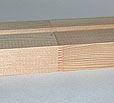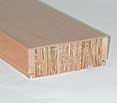Advancements in the manufacture of wood windows and doors
Finger-jointed lumber
Finger-jointed lumber is another engineered product often used by window and door manufacturers in unexposed doorjambs and selected window components. Dating back to the 1920s, finger-jointing is a wood processing technique that consists of cutting notches into the ends of wood pieces, and joining them into longer pieces with an adhesive.
Finger-jointing and edge gluing (blocks of wood that are bonded together) offers some of the same properties provided by LVL in terms of reducing warping, twisting and bowing. Finger-jointed and edge-glued boards stay straighter than and have improved dimensional stability over solid sawn lumber. Finger-jointing is also advantageous because longer and wider knot-free boards can be produced from young growth trees that would otherwise produce a larger proportion of lower quality material.
Window and door manufacturers sometimes use finger-jointed wood for products that are painted. Finger-jointed wood may be used as a paint/ stain grade jamb product where the enhanced properties of LVL are not necessary. Other applications such as a paint/stain grade patio door may require the design properties that LVL offers in order to perform adequately in the field. To meet aesthetic as well as dimensional performance requirements, finger-jointed wood and LVL may be integrally attached to form a single component. The resultant engineered wood component features the beauty of solid wood and the stability and strength of LVL.
Weather resistance
As natural wood is composed of millions of minute cells, it is hygroscopic, or moisture absorbing. Cut wood is dimensionally influenced by shifts in moisture content caused by changes in the surrounding environment. Therefore, careful handling and quick finishing of raw wood by the window manufacturer is essential to prevent checking, warping, and changes in shape.
Typically, for exterior window and door applications, all exposed wood components, including engineered wood, are treated with a preservative and insect repellent to prevent decay and damage.
Both LVL and finger-jointed wood may be used in their raw state as a frame or jamb element after treatment with water repellent and preservative in accordance with the WDMA I.S.-4-99 Standard. That standard is recognized as "an internationally recognized specification for the water-repellent preservative non-pressure treatment of exterior wood and wood cellulosic composite millwork products." It is also referenced by HUD and FHA in their Minimum Property Standards and by many other government and private agencies in their construction specifications.
The general purpose of the treatment, according to WDMA I.S.-4-99 is to "retard swelling due to changes in moisture conditions and to reduce attack by decay and stain organisms." Specifically, WDMA I.S.-4 identifies the following general properties for a water-repellent formulation:
- It must contain "a wood preservative registered for use by the Environmental Protection Agency under the latest revision of the Federal Insecticide Fungicide and Rodenticide Act (FIFRA)."
- It shall not "objectionably discolor wood, shall not cause objectionable surface residue, nor have any objectionable odor."
- When properly applied, it "shall be compatible with other materials used in the fabrication of the treated product."
- It shall be "stable at normal manufacturing conditions and shall not separate or precipitate components which will adversely affect the appearance, the effectiveness of the treatment or the ability to finish the treated product."
- When properly applied, "it shall effectively retard the formation of stains, decay and swelling that would adversely affect the appearance and/or serviceability of the millwork."












